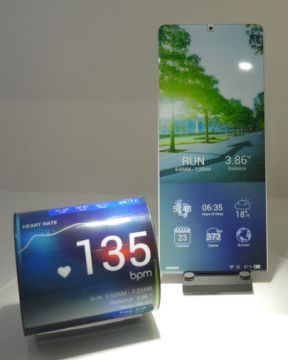 Smartphones – It is easy to become fascinated by some of the high tech product concepts seen at exhibitions. The best of these are a blend of highly creative industrial design and technology that is at, or even just a bit beyond, the state of the art.
Smartphones – It is easy to become fascinated by some of the high tech product concepts seen at exhibitions. The best of these are a blend of highly creative industrial design and technology that is at, or even just a bit beyond, the state of the art.
In the world of displays, perhaps the most interesting product concepts put forth during the past few years have embodied wearable and flexible displays. Starting as early as 2009, Kyocera has presented a variety of particularly eye catching product concepts. The most recent of these is a so-called wearable and collapsible smartphone that is code named Proteus.
Kyocera presented the company’s most recent Proteus beta designs at CEATEC, Japan’s largest consumer electronics show. These designs are reported as currently being used for test purposes.
The Proteus phone is not only flexible but ultrathin, lightweight and can be arranged in three distinct physical configurations.
The device can be held in the user’s palm in the same manner as a smartphone. In this mode, it is operated much as a conventional cell phone.
The Proteus can be wrapped around the user’s wrist like a bracelet. Sensors would be located behind the display, against the user’s skin, with the capability to measure biological information such as heart rate. Levels of user activity could also be measured such as how fast the user is walking or running as well as the number of steps taken.

The Proteus can also be draped or wrapped over a thin rail. This configuration is referred to by the company as “clip style” and could, for example, be used by someone riding a bicycle, in which case the Proteus could be clipped to the handlebar.
Turning Proteus or any of the Kyocera product concepts into a real device will require the development of several technologies. Some of the issues and potential solutions identified and discussed by Kyocera over the years include:
The display: a flexible AMOLED is a leading candidate. One unique and challenging aspect of the Proteus design is that the display is frameless.

The keys: some Kyocera concept devices have integrated key pads. One interesting proposal is to utilize keys that have shape memory. With this capability, the keyboard would present a flat surface when not in use. A kinetic charging method based on piezoelectric generators could be used to bring the keys back into shape when desired.
The battery: one approach would require development of a flexible battery. Another, perhaps more easily achieved approach, would use a segmented battery. A somewhat more exotic solution is a design that is based on the inclusion of piezoelectric generators within the device. This approach is intended to turn the kinetic energy associated with folding the device into an electric charge.
With the lengthy track record of product concepts, it would appear that Kyocera has a real interest in commercializing at least some of these innovative technologies. – Arthur Berman

